Exploring Liquefied Petroleum Gas Grills: Benefits and Care
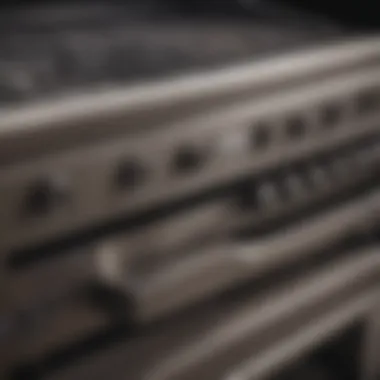

Intro
When it comes to outdoor cooking, liquefied petroleum gas (LPG) grills stand out in both versatility and convenience. Renowned for their efficiency, these grills allow homeowners and culinary enthusiasts to whip up mouthwatering dishes in their backyards. With the summer sun shining and barbecues beckoning, understanding LPG grills is paramount. Not only do they provide a means to achieve that perfect sear on a steak, but they also come packed with functionality designed to make cooking a breeze and to eliminate the fuss often associated with charcoal grilling.
The popularity of LPG grills has soared, spurring innovative designs tailored to a range of tastes and preferences. Whether you're hosting an alfresco dinner for friends or family, or you're simply looking to elevate your weekday dinners, knowing the ins and outs of these grills can make a world of difference.
This article delves into the nuts and bolts of LPG grills – exploring their design, functionality, benefits, and safety considerations. In addition, we’ll take a look at how these grills can complement your outdoor space, making it a perfect social spot for gatherings.
As we wander through this exploration, expect to discover practical tips for maintenance and for arranging memorable outdoor meals. So, if you’re ready to become the grill master of your neighborhood or simply want to make the most of your outdoor experiences, hang tight as we ease into the details of liquefied petroleum gas grilling.
Understanding Liquefied Petroleum Gas Grills
In today's grilling landscape, understanding liquefied petroleum gas (LPG) grills is crucial for anyone looking to elevate their outdoor cooking experience. This section sheds light on why these grills have carved a niche in the marketplace and the numerous benefits they offer to enthusiasts and casual users alike.
Advantages of LPG Grills
LPG grills are popular for many reasons. First off, their heat production is impressive. They heat up quickly, enabling users to start grilling in a fraction of the time it would take a charcoal grill. When the flaming grill is ready, it’s all systems go; you can sear, smoke, or roast your meat with minimal hassle.
Moreover, LPG grills are known for their efficiency. Unlike charcoal, which can be unpredictable in terms of temperature maintenance, propane burns at a consistent rate. This predictability gives you more control over your cooking, allowing each steak or veggie to be grilled to perfection.
Considerations When Choosing LPG Grills
When delving into the world of LPG grills, several factors demand attention. The safety measures in place, for instance, are paramount. Grilling should never come at the expense of safe practice; hence, understanding how to handle propane and its storage becomes essential.
Another critical element is maintenance. An LPG grill, like any equipment, requires care to function effectively. Recognizing what materials are best suited for barbecue grills and how to keep them in tip-top shape will prolong their lifespan and enhance the grilling experience.
In summary, grasping the underlying aspects of LPG grills is more than just knowing how to cook. It's about making informed decisions regarding your grilling method, safety considerations, and the long-term enjoyment of your outdoor culinary pursuits.
Definition of Liquefied Petroleum Gas
Liquefied Petroleum Gas (LPG) refers to a mixture of hydrocarbon gases, mainly propane and butane. These gases exist in a gaseous state at normal temperature and pressure but transform into a liquid when compressed. This feature makes LPG convenient for storage and transportation. When you turn on your grill, this liquid converts back into gas, allowing it to ignite easily with a spark or flame. Understanding what LPG is formed of helps clarify not just how it works but its advantages over other fuel sources, like charcoal or wood.
History and Evolution of LPG Grills
Historically, the use of LPG as a fuel source escalated during the early 20th century. Originally used for heating and cooking in homes, it soon zigzagged its way into the outdoor grilling scene. The invention of portable LPG tanks ushered in a new era of grilling convenience, allowing people to take their outdoor cook-offs wherever they fancied.
Over the decades, the technology surrounding LPG grills has advanced tremendously. Early models were often rudimentary, lacking many features that are commonplace today. Modern grills now include features like electronic ignition systems, multiple burners for better heat distribution, and built-in thermometers that take the guesswork out of cooking. As a result, whether it’s a simple backyard barbecue or a fancy tailgate gathering, LPG grills are now a go-to for many grilling aficionados.
As public interest in outdoor cooking continues to rise, the evolution of LPG grills is expected to keep up with innovative design, energy efficiency, and user comfort, providing an abundance of choices for everyone, from novice grillers to seasoned pros.
Understanding the CAM: Liquefied Petroleum Gas grills offer both flexibility and consistency, transforming outdoor cooking into a reliable and enjoyable pursuit.
Types of LPG Grills
Understanding the various types of Liquefied Petroleum Gas (LPG) grills is pivotal for anyone looking to enhance their outdoor cooking experience. The type of grill you choose can have a significant impact not only on your cooking style but also on the practicality and enjoyment of the grilling process. Several factors come into play when selecting between options, such as convenience, installation requirements, and the distinct cooking capabilities that different grills offer. This section aims to delve into the nuances and unique characteristics of portable, stationary, built-in, freestanding, and infrared grills to provide a thorough understanding of what’s available.
Portable vs. Stationary Grills
Portable grills are often considered the champions of convenience. These lightweight, easily transportable units allow for grilling anywhere—be it a picnic in the park, a tailgate event, or a casual family gathering in the backyard. They usually run on smaller propane tanks, making them perfect for those on the go. Not surprisingly, this flexibility is a big selling point for many grill enthusiasts. However, their limited cooking area and fewer features compared to larger models can make them less appealing for serious cooks.
On the other hand, stationary grills typically offer larger cooking surfaces, allowing one to prepare meals for bigger gatherings or cook multiple dishes at once. They often resemble small outdoor kitchens and come with various features, such as side burners or integrated storage. That said, these grills do require a more permanent installation and are not as easy to move. Therefore, understanding where you primarily intend to use the grill is essential—it informs whether you need flexibility or permanence in your setup.
Built-in Grills vs. Freestanding Models
When considering built-in grills, think fancy outdoor kitchens. These are often part of a larger installation, integrated into cabinetry or stonework. Built-in models can provide a seamless look and often come loaded with features that enhance the grilling experience. However, they do require more time and investment to set up, which may not appeal to everyone. If planning to make a space dedicated solely to grilling, a built-in model can elevate the ambiance and functionality of the area.
In contrast, freestanding models are enticing for their versatility. They are easier to install and more flexible when reconfiguring outdoor spaces. Freestanding grills can often be wheeled around, offering the opportunity to tailor your backyard layout based on the occasion.
"Choosing the right grill type is as essential as picking the right ingredients for your meal. Each offers a unique function that shapes how and where you enjoy cooking."
Infrared Grills and Their Benefits
Infrared grills are a modern twist on traditional grilling. Instead of using conventional methods, they rely on infrared technology that directly heats the food, cooking it more evenly and quickly. This technology provides higher temperatures in a shorter time frame, making it ideal for searing meats and keeping juices locked in.
The benefits of infrared grilling extend beyond speed; they include a significant reduction in flare-ups, less smoke, and better fuel efficiency. These grills are particularly beneficial for those who value quality and who might wish to replicate professional cooking techniques at home. However, they can be pricier than other grill types, which is an important consideration.
When weighing the options, homeowners and cooking aficionados must assess their individual needs and preferences. The type of grill one chooses isn’t just about functionality; it also reflects a lifestyle and dining culture. From casual barbecues to full-blown culinary escapades under the stars, the right LPG grill can make all the difference.
Materials Used in LPG Grills
When it comes to liquefied petroleum gas (LPG) grills, the materials used in their construction play a crucial role in performance, durability, and even aesthetic appeal. The right choice of materials can enhance the grilling experience, making it easier to cook delicious meals while ensuring longevity and effective heat retention. This section delves into the materials commonly used in LPG grills, helping homeowners and grilling enthusiasts understand their benefits and considerations.
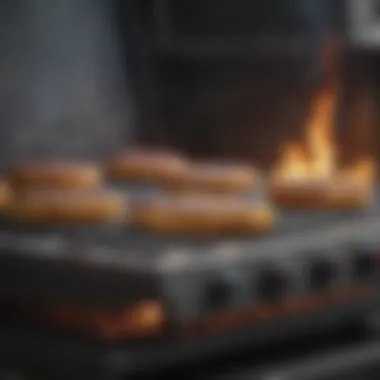
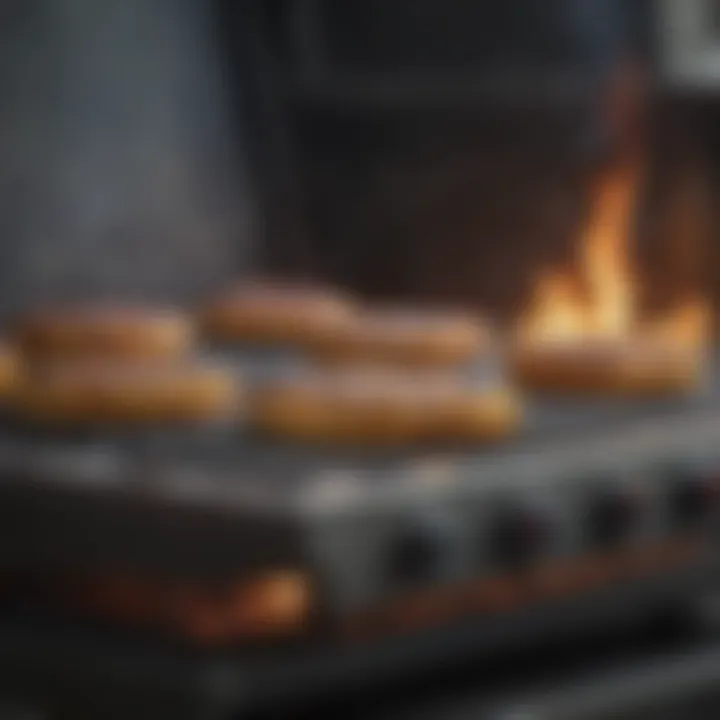
Steel and Its Variants
Steel is often the backbone of most LPG grills, thanks to its exceptional strength and resilience. The steel used in grills can come in various forms, each with distinct advantages and drawbacks:
- Stainless Steel: This is the star of the show. It not only has a sleek look but also resists rust and corrosion, making it suitable for outdoor conditions. Virtually maintenance-free, stainless steel retains its aesthetic even after years of use, which is why many premium grill models proudly flaunt this material.
- Porcelain-Coated Steel: This variant is not only affordable but also adds an extra layer of protection against rust. However, it may chip over time, exposing the steel underneath, which can lead to rusting if not taken care of. It's a classic choice for those who want a balance between cost and performance.
- Galvanized Steel: While this material doesn’t rust as readily as untreated steel, it can dull over time and may not provide the same durability or visual appeal as stainless steel. Nonetheless, it can be found in budget-friendly grills, making it more accessible for novice grillers.
Ceramic and Cast Iron Grills
Ceramic and cast iron have unique charm and functionality when it comes to grilling. Cast iron is renowned for its heat retention capacity. It holds and redistributes heat evenly, which ensures perfectly cooked food. Here’s a closer look:
- Ceramic Grills: Often found in kamado-style grills, ceramics are excellent insulators. They help maintain consistent temperatures with less fuel, which can lead to energy savings. Besides, many choice for aesthetics—they often come in vibrant colors that catch the eye.
- Cast Iron Grills: While heavier, cast iron grills require some maintenance to prevent rust. With a bit of care—a good seasoning here and there—they can outlast a lifetime. The surface creates those coveted grill marks that many grill enthusiasts adore. It's an ideal material for those who appreciate traditional grilling methods and results.
Materials and Longevity
Understanding how materials can affect the lifespan of your LPG grill is vital. A grill constructed from top-notch materials not only performs better but also stands the test of time. Here’s how:
- Quality of Materials: Higher quality materials often lead to longer durability. Investing in a grill made from stainless steel or well-constructed cast iron can provide years of reliable use.
- Maintenance: Regardless of the material, regular cleanup and care can extend the life of any grill. It’s crucial to clean the connectors and burners to avoid rusting and blockages, ensuring a safe grilling experience.
- Environmental Exposure: Grills that face harsh weather conditions without protection will naturally deteriorate faster. Ensuring your grill has a suitable cover when not in use can dramatically enhance its longevity.
A grill is an investment, so choosing the right materials is part of securing your culinary future.
Key Features of LPG Grills
Understanding the key features of liquefied petroleum gas grills is essential for anyone looking to enhance their outdoor cooking experience. Each feature, from cooking area to heat control, plays a significant role in how well the grill performs and how enjoyable the cooking process can be. By considering these features, homeowners can make more informed decisions that align with their cooking needs and backyard layouts.
Cooking Area and Grate Design
The cooking area of an LPG grill is often the first feature that catches the eye. A larger cooking surface allows for preparing meals for bigger groups, which is especially beneficial for gatherings or family get-togethers. A grill with ample space can handle multiple items at once — like burgers, hot dogs, and veggies — ensuring everyone gets their meal fresh and hot.
Moreover, the design of the grates can influence both cooking techniques and flavors. Cast iron grates hold heat exceptionally well, creating beautiful sear marks, while stainless steel grates are generally easier to clean and maintain. Some grills even boast porcelain-coated grates, which offer non-stick properties.
"A good grate design is not just about aesthetics; it affects how evenly your food cooks."
Heat Control Mechanisms
Heat control is another clause that's vital to the success of any grilling endeavor. Most quality LPG grills come equipped with multiple burners that offer adjustable heat settings. This allows the chef to master the art of indirect cooking, where food is placed away from direct flames, creating a slower, more controlled cooking environment.
Some advanced models include infrared burners that can generate high temperatures quickly for searing meats. This technology can drastically cut down on cooking time while providing that coveted charred flavor. Fluidity in heat control means you can seamlessly transition from high heat for grilling steaks to lower settings for simmering sauces.
Propane Tank Compatibility
When it comes to compatibility, not all grills are created equal. Grills that are designed to work specifically with standard propane tanks ensure hassle-free usage. Look for models that can easily connect to either a standard 20-pound propane tank or a more extensive system for larger needs. Ensuring compatibility simplifies the process of refueling, maintaining a high level of convenience throughout grill operations.
Many manufacturers are incorporating features such as built-in gauges, which let users promptly identify fuel levels. This can prevent the frustrating scenario of running out of gas mid-cook. Ultimately, a grill that simplifies additional tasks – like refueling – enhances the overall grilling experience and keeps the focus on enjoying the meal.
The Advantages of Using LPG Grills
LPG grills have become increasingly popular among homeowners and outdoor cooking enthusiasts. This section highlights the myriad benefits that come from using these grills, focusing on efficiency, environmental considerations, and their versatility in different cooking techniques. By understanding these advantages, one can make an informed choice about the best grilling option available.
Efficiency and Heat Production
When it comes to grilling, efficiency is king. LPG grills excel in heat production and recovery. They can heat up in mere minutes—just a flick of the ignition—allowing you to get right down to cooking. Unlike charcoal or wood, which can take a long time to reach the desired temperature, propane burns clean and hot, giving you consistent results.
- Fast Preheating: With most LPG grills, you will find a robust heating capability that ensures that your cooking surface reaches the desired temperature quickly.
- Consistent Heat Distribution: Thanks to various burner configurations, heat is often distributed evenly across the cooking surface. This feature reduces cold spots, ensuring perfectly grilled meat or vegetables.
- Efficiency of Fuel Usage: Propane burns cleanly and efficiently, so you’ll use less fuel compared to other options, which can save you money in the long run. An average gas grill can produce heat effectively with very little fuel wasted, making them an economical choice.
"Using a well-maintained LPG grill can offer impressive efficiency while grilling, allowing for enjoyable outdoor cooking without excessive fuss."
Environmental Considerations
Sustainability is a growing concern in our modern world, and the LPG grill holds some advantages here as well. While no grilling method is entirely without impact, LPG grills emit fewer pollutants compared to charcoal options.
- Lower Carbon Emissions: When you compare LPG to charcoal, propane burns cleaner, leading to a reduction in harmful emissions. This can contribute to less air pollution in your area.
- Efficient Resource Use: Propane is derived from natural gas processing and petroleum refining, and thanks to its effectiveness, it is often a more resource-efficient choice compared to solid fuels like charcoal, which may involve deforestation for production.
- Potential for Biopropane: Emerging technologies are working on developing biopropane, made from renewable resources, which may further reduce the environmental impact of grilling with LPG.
Versatility in Cooking Techniques
Another standout feature of LPG grills is their versatility in food preparation. They allow you to grill, sear, roast, and even bake, broadening your cooking repertoire.
- Multi-Functionality: Many LPG grills come equipped with various settings and attachments, such as rotisserie kits or side burners. This allows users to prepare a wide range of dishes all on the same grill.
- Temperature Control: With knobs for regulating heat and various cooking zones, you can cook different items at once, or apply different temperatures across the surface. From delicate vegetables to thicker cuts of meat, you have the flexibility to handle it all.
- Searing Capabilities: Some grills are specifically designed to reach high temperatures for searing, meaning you can achieve that professional-quality crust on meats right from your backyard. You can also use indirect heating methods, allowing for slow cooking delicate items without burning.
Safety Considerations for LPG Grill Use
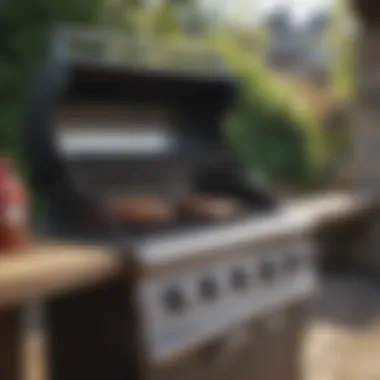
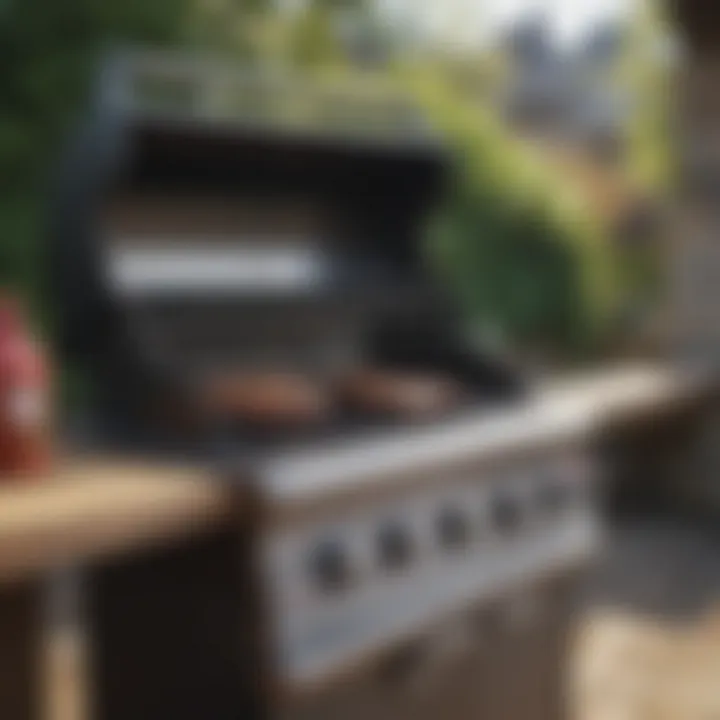
Using LPG grills safely is absolutely crucial. The thrill of grilling can quickly turn into a nightmare if safety precautions aren't followed. Understanding how to handle liquefied petroleum gas safely can save lives and property. In this section, we’ll dive into essential safety guidelines that every user needs to be aware of.
Proper Ventilation and Location
When it comes to grilling, location is everything. Ideally, LPG grills should be placed outdoors, away from any flammable structures such as wooden fences, garages, and overhangs. A good rule of thumb is to position your grill at least ten feet away from your home or any potential hazards. This ensures that fumes and any possible ignition sources are kept at a healthy distance.
The importance of proper ventilation cannot be overstated. A well-ventilated area allows for the quick dispersal of any gas leaks, reducing the chance of an explosion. If you’re grilling in a semi-enclosed space, make sure there’s adequate airflow. Consider installing a hood or exhaust fan to keep the air circulating. Here is a checklist:
- Ensure adequate distance from structures: At least 10 feet is a safe bet.
- Check for wind direction: Position the grill where wind blows away from people.
- Use in open areas: Avoid covered patios unless they're designed for grilling.
"Safety should not be an afterthought; it's the first ingredient for a great grilling experience."
It’s always a smart move to scout your surroundings before lighting up. Remember to keep combustible materials far away.
Handling Propane Safely
Handle propane cylinders as if they were full of liquid gold, because they can certainly bring a world of trouble if mismanaged. First and foremost, always store your propane tanks upright and in a cool area that is well-ventilated. Never keep them in a closed space, especially basements or garages, where gas could accumulate unnoticed.
Check for leaks regularly. You can do this by applying soapy water to the connections. If you see bubbles forming, it’s a sign of a leak. Never use a match or lighter to inspect for leaks; this is a surefire way to get into deep trouble. Always turn off the gas valve on the tank before disconnecting it.
Some additional handling tips include:
- Transport tanks securely: Ensure they’re secured upright in a vehicle.
- Check for expiration dates: Older tanks can pose greater hazards.
- Educate the family: Everyone should know where the shut-off valve is located.
Emergency Procedures and First Aid
In the unfortunate event that something goes awry, knowing emergency procedures can make a world of difference. Firstly, always have a fire extinguisher handy, ideally a Class B extinguisher that’s meant for flammable liquids and gases. If there’s a fire, never attempt to move the grill. Instead, shut off the gas and aim the extinguisher at the base of the flames.
First Aid Tips:
- Burns: For minor burns, cool the area with running water for at least 10 minutes. Cover with a sterile bandage, and seek medical care for more serious burns.
- Inhalation of propane fumes: Move the person to fresh air immediately and call for emergency medical help if they are unresponsive or having trouble breathing.
- Gas leaks: Evacuate anyone in the area and alert local gas services.
Taking 30 seconds to plan your response to emergencies could save lives, offering peace of mind for you and your guests.
Maintenance and Care for LPG Grills
Proper maintenance and care for LPG grills ensures they deliver peak performance and longevity. By regularly tending to your grill, you not only maintain its efficiency, but also enhance the safety of its operation. Grilling should be a joyful experience, not a chore plagued with malfunctions or risks. Let’s break down some essential practices that every grill owner should adopt.
Routine Cleaning Practices
Cleaning your LPG grill should be like brushing your teeth – something done regularly to avoid bigger problems later. After each use, take a moment to brush down the grates with a wire brush. This removes food residue and grease that can build up, affecting flavor and function. And don’t stop there; a deep clean every month or two is vital. Here’s a handy routine:
- Turn off the propane tank and disconnect it before getting started.
- Remove the grates and any flavorizer bars and give them a thorough wash with warm, soapy water.
- Clean the grease tray and any other removable parts. A good rule of thumb is to check this every few uses to avoid grease fires.
- Wipe down the exterior with a gentle cleaner suitable for the material.
- Use a damp cloth to clean the burner assembly and make sure nothing is blocking the gas flow.
Remember, a clean grill not only looks good but performs better too, keeping the flavors of your meals intact.
Seasonal Maintenance Checks
As seasons change, so do the demands on your grill. Conducting a seasonal check can save you a lot of headaches come grilling season. Before you fire up for the summer, consider these steps:
- Inspect the hoses. Look for any cracks or brittleness. If anything seems off, it’s best to replace them.
- Check the burners. Make sure that they’re clear of clogs which could disrupt your flame.
- Test the propane tank. If your grill has been sitting unused, make sure it's not rusty and the valve works smoothly.
- Wash the exterior and grill surfaces to ensure it’s free from debris and grime.
Being proactive now will prevent unwanted surprises down the line, keeping your grill in tip-top shape.
Troubleshooting Common Issues
Even with the best maintenance, hiccups can happen. Here are a few common problems you might face and how to tackle them:
- Inconsistent Flame: If your grill’s flames aren’t regular, it might be caused by clogged burners. Take a wire brush or pin to clean out any debris.
- Difficulty Igniting: Ensure your ignition system is clean and check the battery if it’s battery-operated. Sometimes, a simple reset is all you need.
- Gas Leaks: If you smell gas, turn off the tank and check all connections with soapy water. Look for bubbles that indicate a leak. This is critical for safety!
Always consult your grill’s manual for specific troubleshooting steps related to your model.
Taking these preventive measures ensures your LPG grill doesn’t just work, it thrives. By committing to routine cleaning, seasonal checks, and addressing common problems head-on, you’re well on your way to grilling success. Happy cooking!
Comparing LPG Grills with Other Grill Types
In the realm of outdoor cooking, the type of grill one chooses can significantly affect not just the cooking process but also the flavor and experience of the meal. Understanding the distinctions among various grill types is essential for homeowners, party hosts, and cooking enthusiasts looking to elevate their culinary sessions. LPG grills have become popular, prompting comparisons with other grilling methods like charcoal and electric grills. Exploring this subject offers valuable insights into performance, convenience, and flavor, which can guide users in making informed decisions that suit their needs.
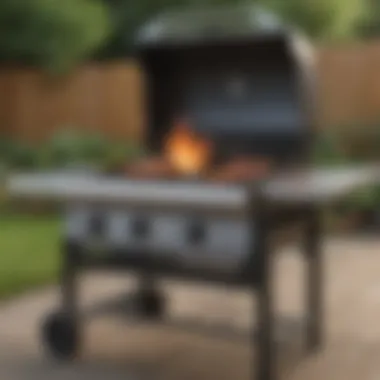
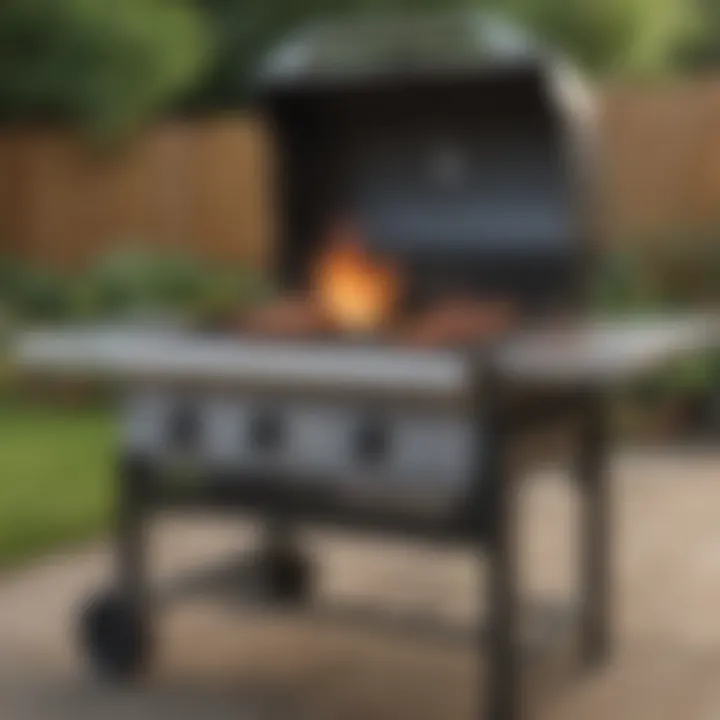
LPG Grills vs. Charcoal Grills
When we match LPG grills against charcoal variants, a classic rivalry appears. Charcoal grilling brings a smoky flavor that many consider the epitome of outdoor cooking. However, it can require considerable patience and effort—think waiting for coals to turn white and eating smoke instead of food.
On the other hand, LPG grills provide a user-friendly alternative that allows for quick lighting and faster cooking. The temperature control is also finer, enabling precise heat adjustments. Here’s a breakdown of key points:
- Flavor Differences: Charcoal has a unique, smoky essence. LPG grills can mimic this effect with the right seasoning but might not reach the same depth in flavor.
- Convenience: LPG grills ignite instantly and heat up quickly. Charcoal requires more preparation time.
- Clean-up: With LPG, you’re left with fewer ash residues, making the clean-up process much simpler after those garden cookouts.
"Choosing between a charcoal and an LPG grill often boils down to flavor preference versus convenience."
LPG Grills vs. Electric Grills
Electric grills bring modernity into the grilling equation, especially for urban dwellers lacking outdoor space. When comparing them with LPG grills, one finds that each has its merits but appeals to different lifestyle choices.
- Cooking Flexibility: LPG grills excel in versatility, allowing users to grill, sear, and smoke. Electric models tend to provide less heat, which may hender traditional grilling techniques such as charring and caramelizing.
- Usage Location: Unlike LPG grills, which may require outdoor spaces with proper ventilation, electric models can be a go-to in confined places. Think of apartments where smoke alarms can be too sensitive.
- Flavor and Searing: The ability of LPG grills to achieve higher temperatures means they can provide the sought-after sear on meats not often replicated with electric grills.
Cost Considerations in Decision-Making
Price points certainly sway this ongoing discussion. Here, the costs of initial purchase, maintenance, and gas or power supply come into play. Here's what to think about:
- Initial Investment: LPG grills can vary widely in price, often aligning closely with their charcoal counterparts. Electric grills, meanwhile, often have a wider range due to their varying sizes and capabilities.
- Operating Costs: Propane prices fluctuate, but LPG generally provides greater longevity per usage compared to charcoal briquettes. Electric grills might have lower operation costs, especially for households that prioritize energy-efficient appliances.
- Value Over Time: Evaluate not just the initial price tags but what each type of grill brings over time, durability, and the quality of food produced. Offering rich flavors often justifies a higher upfront cost for many grilling enthusiasts.
Understanding these comparisons sets the stage for more informed decision-making, guiding consumers towards the right choice that will align with their culinary aspirations.
Environmental Impact of LPG Grilling
Understanding the environmental impact of liquefied petroleum gas (LPG) grilling is vital in today’s world where sustainability plays a key role in consumer choices. As homeowners and enthusiasts of outdoor cooking become more conscientious, knowing how LPG usage affects our planet is increasingly relevant. While many are drawn to the convenience and efficiency of LPG grills, an in-depth look into their carbon footprint, sustainable practices, and the regulations governing their use reveals a complex relationship with the environment.
Carbon Footprint Analysis
When analyzing the carbon footprint of LPG grilling, it's crucial to consider both direct and indirect emissions. On the surface, LPG is often seen as a cleaner-burning alternative to charcoal or wood. This is true to an extent, as burning LPG emits fewer particulates and greenhouse gases compared to these traditional methods. However, there's more beneath the surface. For instance, the extraction and transportation of propane can release substantial amounts of CO2 into the atmosphere.
- Direct emissions: When LPG is burned, it typically produces water vapor and carbon dioxide, with minimal soot. This means cleaner air in your backyard but keep in mind the source of LPG.
- Indirect emissions: The ecological impact doesn’t stop there. The production and refinement of LPG contribute to its overall environmental footprint. Studies show that, while using LPG significantly reduces air pollutants, the upstream processes can leave a mark.
"LPG may be cleaner at the point of use, but the journey from extraction to grill highlights a more layered environmental impact."
Sustainable Practices in LPG Utilization
Adopting sustainable practices in the use of LPG can make a notable difference in minimizing its overall environmental impact. A few steps to consider include:
- Refilling over Replacement: Many homeowners often buy new propane tanks instead of refilling old ones. This contributes to unnecessary production waste. Opt for refillable cylinders whenever possible.
- Use Efficient Grilling Techniques: Turning down the heat can not only save on propane but also lower emissions. Consider using indirect grilling methods, which allow for slower cooking and lower temperatures.
- Regular Maintenance: Keeping grills in top shape reduces fuel consumption. Ensure burners are cleaned regularly, ensuring even heat and efficient fuel use.
Regulatory Considerations for LPG Use
In many regions, the use of LPG is subjected to a range of regulations aimed at mitigating its environmental effects. This is essential for ensuring that consumers are making environmentally responsible choices. Key regulations often include:
- Emission Standards: Various governments enforce strict emission standards on LPG appliances. These regulations ensure that any harmful outputs are kept to a minimum.
- Safety Regulations: While not strictly environmental, safety regulations prevent mishaps that could lead to environmental disasters such as leaks and spills.
- Incentives for Cleaner Technologies: In some areas, there are grants or subsidies available for upgrading to more energy-efficient or environmentally friendly LPG systems.
Culmination: The Future of LPG Grilling
As we ponder over the trajectory of LPG grilling, it's clear that this cooking method is undergoing a sophisticated evolution. The future holds real promise, not just in terms of technology, but also in addressing ecological concerns and changing consumer behaviors. With more homeowners turning to outdoor cooking as a staple of their culinary experience, understanding these advancements can be crucial.
Emerging Technologies in LPG Grilling
LPG grilling is poised to benefit from a suite of emerging technologies that aim to enhance efficiency and user experience. Smart technology integration stands out as a game changer. Consumers are increasingly looking at grills that come equipped with Bluetooth or Wi-Fi connectivity, allowing them to monitor cooking temperatures from their smartphones. This feature offers peace of mind to the busy party host who wants to multitask without burning the burgers.
Additionally, innovations in burner designs promise improved heat distribution. Grills like those from Weber now feature advanced searing systems that cater to a more varied cooking style, enhancing flavor profiles. Moreover, many manufacturers are now focusing on creating grills that expedite preheating, crucial for those spontaneous gatherings. Overall, the embrace of smart technology isn’t merely for convenience; it’s also paving the way for more sustainable practices.
Trends in Consumer Preferences
As society leans into the convenience of outdoor cooking, trends are emerging that place a premium on sustainability and versatility. Today’s consumers are notably more aware of the environmental impact of their choices. This shift is prompting manufacturers to adopt greener practices, such as using recyclable materials in grill production and promoting propane options with lower carbon footprints.
Furthermore, versatility is a key consideration. Homeowners are increasingly hunting for grills that offer additional features like rotisserie kits or multiple cooking zones. The demand for adaptability, such as transforming from a grill to an oven setup, has seen notable interest.
"The grill that cooks everything has become a mantra for today's discerning cook."
This desire for multifunctionality means customers are seeking out brands that don’t just sell grills but offer a holistic grilling solution. To meet this demand, many brands are now bundling various accessories and add-ons, ensuring consumers feel they’ve made an investment rather than just a purchase.
Final Thoughts on LPG Grills
LPG grills have firmly established their place in outdoor dining culture. As we look towards the horizon, there are vast opportunities for growth and improvement. With ongoing innovations and shifting consumer expectations, these grills can evolve further, ushering in a golden age for outdoor cooking.
The seamless blend of tradition and modern technology is essential. Whether it’s a gourmet chef or a weekend warrior firing up the grill, LPG offers a dynamic experience that simply can't be replicated through other mediums. The future promises grills that not only satisfy our appetites but also resonate with our ideals of sustainability and efficiency.
In essence, LPG grilling seems ready to step into the limelight. With every grill refined, every piece of technology reimagined, and every flavor explored, the journey ahead is as exciting as the tantalizing aroma wafting from a perfectly grilled steak.















